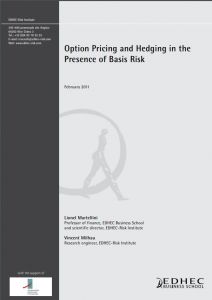

Option Pricing and Hedging in the Presence of Basis Risk
This paper addresses the problem of option hedging and pricing when a futures contract, written either on the underlying asset or on some imperfectly correlated substitute for the underlying asset, is used in the dynamic replication of the option payoff. In the presence of unspanned basis risk modeled as a Brownian bridge process, which explicitly accounts for the convergence of the basis to zero as the futures contract approaches maturity, we are able to obtain an analytical expression for the optimal hedging strategy and corresponding option price. Empirical analysis suggests that the hedging demand against basis risk is an important ingredient of the hedging strategy. For reasonable parameter values, we also find the replication error implied by the optimal strategy to be substantially lower than that implied by heuristic strategies routinely used in practice.
Author(s):
Summary:
This paper addresses the problem of option hedging and pricing when a futures contract, written either on the underlying asset or on some imperfectly correlated substitute for the underlying asset, is used in the dynamic replication of the option payoff. In the presence of unspanned basis risk modeled as a Brownian bridge process, which explicitly accounts for the convergence of the basis to zero as the futures contract approaches maturity, we are able to obtain an analytical expression for the optimal hedging strategy and corresponding option price. Empirical analysis suggests that the hedging demand against basis risk is an important ingredient of the hedging strategy. For reasonable parameter values, we also find the replication error implied by the optimal strategy to be substantially lower than that implied by heuristic strategies routinely used in practice.
Register to download PDF
Register/Log in| Type : | Working paper |
|---|---|
| Date : | 21/02/2011 |
| Keywords : |
Asset Pricing |

